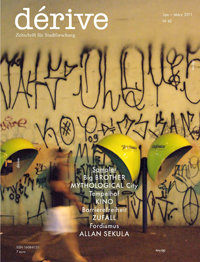Editorial
Das dérive-Jubiläumsjahr ist nun endgültig aus und vorbei und die Redaktion arbeitet bereits tatkräftig an der Umsetzung des nächsten 10-Jahres-Plans. Trotzdem sei ein kleiner Rückblick gestattet: Die im Oktober präsentierte 10-Jahre-dérive-Sonderausgabe Understanding Stadtforschung hat sich zum mit Abstand begehrtesten Heft entwickelt, das wir bisher veröffentlicht haben. Mit keinem anderen Heft konnten wir so viele Leser und Leserinnen erreichen. Der Erfolg beweist uns einmal aufs Neue, wie groß das Interesse an Stadtforschung ist, und spornt uns an den eingeschlagenen Weg weiterzugehen und neue Projekte in Angriff zu nehmen.
Mindestens ebenso erfolgreich wie das Jubiläumsheft war die Premiere unseres Festivals urbanize!, mit dem wir die Inhalte von dérive in ein zehntägiges Veranstaltungsformat gegossen haben. Das Interesse der Besucher und Besucherinnen an den vielfältigen theoretischen und praktischen urbanistischen Erkundungen hat unsere Erwartungen bei Weitem über-troffen. Ganz egal, ob wir querfeldein mit dem Leipziger Spaziergangsforscher Bertram Weishaar durchs äußerste Simmering flanierten, uns mit Klaus Ronneberger, Helmut Weber und Elke Krasny Henri Lefebvres Stadttheorien widmeten oder die Österreich-Premiere des Dokumentarfilms Auf der sicheren Seite von Corinna Wichmann und Lukas Schmid präsentierten: Besuch, Interesse und Rückmeldungen waren überwältigend – danke an alle, die dabei waren, uns hat es echt Spaß gemacht!
Besonders erfreulich war auch das rege Interesse an unserem Aufruf zur Teilnahme an laboratoire dérive, einer situationistischen Stadterkundungsmethode, die wir vor rund 15 Jahren ins Leben gerufen haben. An ihrer Wiederbelebung im Rahmen von urbanize! nahmen neben mehreren Gruppen in Wien auch Gruppen in Zürich, Berlin und Kopenhagen teil. Die komplette Dokumentation des Materials sind wir noch schuldig, weil an der Technik zur adäquaten Abbildung der Forschungsergebnisse nach wie vor gefeilt wird – schließlich soll mit laboratoire dérive langfristig ein virtuelles Gedächtnis der Stadt entstehen. Wir beeilen uns aber, versprochen! Die laboratoire dérive Spielregeln finden sich einstweilen auf www.derive.at und einiges Material ist zwischenzeitlich auf youtube.com/derivemagazin, flickr.com/derivemagazin und facebook.com/derivemagazin zu sehen.
Die aktuelle Ausgabe, dérive 42, hat keinen speziellen Schwerpunkt, wenngleich es wie immer Querverbindungen zwischen den einzelnen Artikeln gibt – Stadt und Kommunikation lautet das verbindende Leitmotiv der Beiträge diesmal. Die Wände der Stadt als Oberfläche für Zeichen spielen hier ebenso ein Rolle wie Videoscreens im öffentlichen Raum, dazu kommen Utopien, wie die Zukunft des Kinos in der Stadt aussehen könnte, Überlegungen, die weit über Kinosäle und Leinwände hinausgehen. Im Beitrag The Mythological City von Peter Wendl geht es um die Fragen, warum wir Zeichen im öffentlichen Raum brauchen und welche Funktion sie erfüllen. Als besonders spannend in diesem Zusammenhang erweist sich São Paulo, weil dort einerseits Werbung im öffentlichen Raum seit 2007 fast gänzlich verboten ist und andererseits die Wände der Stadt übersät sind mit Graffiti und Pixação, einer nur schwer zu entziffernden Schrift, die von Gangs zur Markierung ihres Reviers verwendet wird.
Anthony Auerbach schreibt in seinem Artikel Who is Big Brother? or The Politics of Looking über Videoscreens im öffentlichen Raum und betont ihre Zweideutigkeit: »Urban screens, video screens, like all screens, are equivocal: as much as they display, they conceal.« Als schönes Beispiel für die sich wandelnde Funktion öffentlicher Räume, die man in Osteuropa oft besonders gut sieht, nennt er den Platz der Republik in Jerewan, der Hauptstadt von Armenien. Dort stand groß und mächtig bis 1989 eine Lenin-Statue, später wurde an derselben Stelle ein Kreuz aufgestellt, das vor einigen Jahren einem Videoscreen weichen musste.
Fabian Faltin und Ludwig Engel machen sich – ausgehend von einer für sie sehr unbefriedigenden Diskussionsveranstaltung bei der Berlinale 2010 – in Form von vier Science-Fiction-Szenarien eigene Gedanken über die Zukunft des Kinos. »Zukunftsspekulationen, die sich nur mit der äußeren Verhüllung und gegebenenfalls noch der städteplanerischen Verortung des Kinos befassen, es als Zukunftsmedium aber nicht zu würdigen wissen,« wie das bei der Berlinale-Veranstaltung der Fall war, »greifen demnach zu kurz.«
Drei weitere Artikel im Heft nehmen die Entwicklung des Tempelhofer Feldes in Berlin unter die Lupe – Die Utopie des Nichts von Nikolai Roskamm, stellen die UN-Behindertenrechtskonvention vor, Autor ist Michael Spörke und setzen sich mit der Stadt als einem Ort der Inszenierung des Zufalls auseinander (Klaus Neundlinger). Manfred Russos Dauerbrenner, die Serie zur Geschichte der Urbanität, Teil 31, schildert in der siebten Folge über die Moderne und der zweiten über den Fordismus den ökonomischen Aufstieg und die kulturelle Krise. Das Kunstinsert in diesem Heft hat der amerikanische Künstler Allan Sekula für dérive gestaltet, der bei der Viennale 2010 mit seinem Dokumentarfilm The forgotten Space zu Gast bzw. unlängst im Ludwig Museum in Budapest in einer umfangreichen Werkschau zu sehen war. Mehr dazu von Paul Rajakovics und Andreas Fogarasi auf Seite 32.
Mir bleibt, Ihnen liebe Leser und Leserinnen ein gutes 2011er Jahr zu wünschen, dass es ein spannendes dérive-Jahr werden wird, versprechen wir an dieser Stelle gerne. Für alle, die dérive im neuen Jahr für zwei Jahre abonnieren möchten, warten diesmal drei attraktive Bonus-Bücher, zur Verfügung gestellt vom HdA Graz und der Edition Nautilus.
Christoph Laimer
